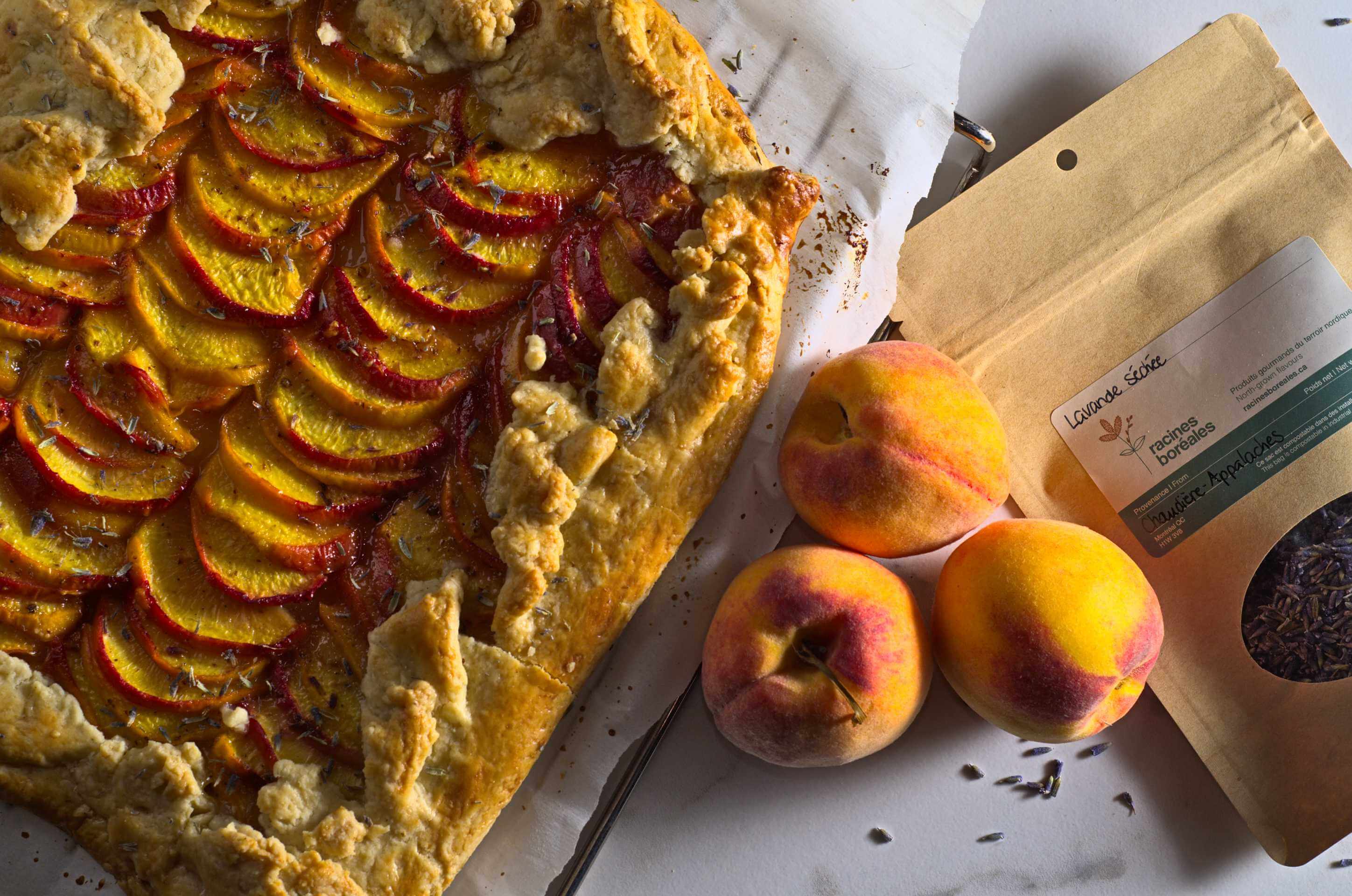It's peach season and it's so short that you absolutely have to take advantage of it! If all the peaches in your basket are ripe at the same time and you're worried about losing some, here's a refreshing recipe you have to try.
What I love about galettes is that they are just as delicious as a pie (it is, in fact, a pie crust that we use), but its more deconstructed look is more forgiving and puts less pressure on the pastry chef. Less perfectionism, more dessert: a good equation in my eyes! In addition, the particular technique of rolling the rectangles of butter brings an absolutely divine flakiness to the dough.
As for the garnish, the combination of peach and lavender is truly exquisite: the floral and fragrant side of lavender perfectly complements the frank and sweet flavor of peach.
This really is a great summer dessert, and it takes less time to make than it seems! Enjoy your food!
- Marie-Philippe
Recipe adapted from “Fall Fruit Galette” by Carla Lalli Music for Bon Appétit

Ingredients
For the dough (ideally, all ingredients are cold):
- 1 and 1/3 cup (180g) flour
- 1 1/2 teaspoon of sugar
- 3/4 teaspoon kosher salt (kosher salt is less salty than traditional table salt – lower the quantity if using traditional salt)
- 3/4 cup cold unsalted butter
For garnish:
- 5-6 ripe peaches, thinly sliced
- 1/3 cup sugar
- 1 teaspoon of Quebec lavender crushed in a mortar
- 1 teaspoon kosher salt
- 1 teaspoon raspberry vinegar or apple cider vinegar
- 1 1/2 teaspoon powdered sweet clover
- 1 tablespoon 15% or 35% cream
Directions
For the dough:
- Prepare the dough: mix the flour, sugar and salt in a large bowl.
- Cut the butter into six rectangular pieces and place them in the bowl with the dry ingredients. Mix to coat the pieces with butter.
- Empty the contents of the bowl onto a clean surface and roll the pieces of butter with a rolling pin until they are flattened. They should look like long, soft strips. Use a pastry scraper to remove them from the work surface or rolling pin if necessary.
- Combine all the strips and flour in the center of the work surface in a small pile and pour in 4 tbsp. of very cold water on it.
- Mix with your hands and the pastry scraper, then, as soon as the water is well distributed in the dough, make a rectangular “pile”. Roll this dough with a rolling pin until you obtain a rectangle whose smallest side will be approximately 8 inches, then fold the dough in 3 like a letter. At this point, the dough will be very inconsistent and will look very crumbly; it's normal.
- Using the scraper, turn the rectangle a quarter turn and roll and fold again. Pick up any stray dough scraps and return them to the main pile as needed. You can add flour to the surface and the rolling pin if the dough tends to stick.
- Turn the rectangle of dough a quarter turn and roll and fold a third time. The dough should start to be more consistent with drier, crumbly ends. By taking a piece of dough in your hand, you should see that it is roughly holding together. If not, twist, roll and fold again.
- Wrap the dough in plastic wrap, then flatten it into a compact disc about 1 inch thick. Refrigerate 30 minutes.
- Roll out the cooled dough until it is about 1/8 inch thick. If the dough cracks around the edge, it doesn't matter: the galette is a deconstructed form of pie; it is much more forgiving! Do not hesitate to flour the surface and the rolling pin abundantly to prevent the dough from sticking. When ready, wrap it around the roll to lift it and place it on parchment paper placed on a baking sheet.
For the filling and assembly:
- Preheat the oven to 400 degrees Farenheit. Mix the sugar, salt and half of the crushed lavender in a bowl. Mix well, then add the sliced peaches. Add the vinegar and the powdered sweet clover. Mix again, gently, so as not to break the peach slices.
- Place the peach slices in the center of the dough, leaving about a 2-inch border all the way around. Fold the dough inward over the fruit filling, pleating it for a prettier effect if desired. Make sure that the edge of the dough does not have holes (otherwise the juices could escape during cooking); if necessary, patch it with other pieces of dough, pressing so that it sticks well.
- Pour the cream into a small bowl, then, using a brush, brush the dough evenly with cream; this will allow it to brown. Sprinkle with sugar if desired.
- Place in the oven and immediately reduce the temperature to 375 degrees Farenheit. Cook for 45 to 50 minutes, rotating the baking sheet halfway through cooking. The dough should be nicely browned, the peaches a little wrinkled and the juices should be bubbling.
- Remove from the oven, sprinkle with the rest of the lavender. Let cool for about 2 hours, then serve. And to add icing to the sundae, you can serve with a drizzle of honey, whipped cream or ice cream!














